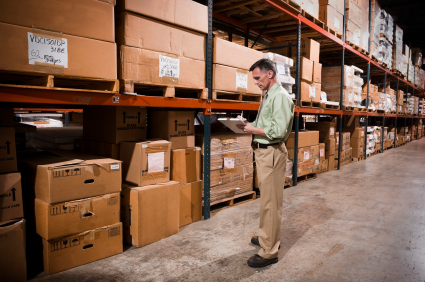
Let’s take a step back from RFID and pay homage to that which came before – the barcode! Barcodes gained in popularity over 40 years ago and have been the workhorse for product identification ever since. Part of the problem with RFID expectations and adoption rate started with the technology being marketed as a replacement to barcodes rather than a supplement. Couple that with RFID taking shape in its own silo outside of the traditional automated data collection (ADC) market and it is no surprise that we ended up with RFID vs barcode like Ali vs Fraser or Yankees vs Red Sox instead of thinking about barcode and RFID as two stars on the same team.
Barcodes are proven technology. There is a great ecosystem in place to support the deployment of both the labels and the infrastructure. A typical manufacturer or warehouse has plenty of choices and there are lots of good integrators that can successfully complete a project. And let’s not forget that deploying barcodes generates a high return on investment because the technology is relatively inexpensive, but packs a lot of punch in its ability to improve inventory management and traceabililty.
Our philosophy is that every facility would benefit from a combination of barcode and RFID. Most integrators sell either a screwdriver or a hammer. As you would expect, they see every project as screws or nails. To the customer, however, there are just business problems. “We need data on this process” or “we need to find things faster in the warehouse”. The best way to help the customer is to evaluate each problem on its own and determine the best tool for that job. The best tool for “picking” is probably different than the best tool at the dock door. Issuing raw materials to a work order likely needs a different solution than creating finished case records.
The barcode isn’t going away anytime soon and RFID is never going to completely replace it, in our view. To us, barcode and RFID are different tools in the tool box that can make a business run better when applied effectively. We need more integrators that can apply either technology or perhaps more integrators to partner and work together so that the best technology is selected for each individual manufacturer’s challenge.
End customers need to be sure their integrator partner has evaluated both barcode and RFID for suitability and made the best choice for each aspect of the business based on value to the customer – not just because “I sell barcode” or “I sell RFID”. It would be rare for an optimized data collection system to be 100% barcode or 100% RFID.
So let’s toast to the barcode and apply it wisely. Cheers!

We are proud to announce that Element ID will be participating in VARTECH 2016 next week – September 12-14.
Please join us on Tuesday 9/13 in the afternoon to see our CEO, Jack Romaine, as a panelist for the Solution Session titled “Tracing Food & Beverage and Pharmaceuticals”.
Session 1: 1-2:30PM located in Hermes 1, 2, 3
Session 2: 2:35-4:05PM located in Hermes 1, 2, 3
Mr. Romaine will be joined by speakers from Zebra, Carlisle Technology, and Blue Rover on the panel moderated by BlueStar’s Rick Bird.
————–
VARTECH is the premiere event in the Channel for education and networking. A combination conference and trade show, VARTECH enables value-added resellers to cultivate rewarding relationships with hardware manufacturers and software solution providers. Vendors and resellers of POS, ADC, Mobility, RFID, Digital Signage and Security can take advantage of one-on-one product demonstrations, phenomenal networking opportunities and educational sessions presented by industry professionals.
Element ID is a specialty integrator focusing on full turnkey RFID solutions for manufacturing and warehouse customers. The company can help in all aspects of the project from design through sourcing of all required equipment and tags, setup, service, and support. Element ID also supplies and integrates barcode scanners, scales, dimensioners, and IoT appliances. A key feature of Element ID projects is the ability to directly integrate with the customer’s existing ERP. WMS, MRP, asset tracking, or other proprietary software solutions.
 It’s difficult to talk about any industry these days without hearing the phrase “Big Data”. In the era of the “Internet of Things” it seems every piece of consumer technology we encounter is communicating with the technology around it and everything we do online ends up in some marketing database. But how can a manufacturer leverage the Big Data innovations to increase profits and improve quality to drive higher sales? Is “Internet of things” real technology and can it help? Let’s get beyond the marketing flash and see how this can benefit manufacturing.
It’s difficult to talk about any industry these days without hearing the phrase “Big Data”. In the era of the “Internet of Things” it seems every piece of consumer technology we encounter is communicating with the technology around it and everything we do online ends up in some marketing database. But how can a manufacturer leverage the Big Data innovations to increase profits and improve quality to drive higher sales? Is “Internet of things” real technology and can it help? Let’s get beyond the marketing flash and see how this can benefit manufacturing.
First, the good news. Most manufacturers already own the costliest part of a Big Data system – the software to house and process the data. This is generally your ERP system but could also be an MES or MRP system. These software systems provide the tools to slice, dice, and analyze the data you collect. Oops. Now the bad news. Most manufacturers are not feeding these systems with real time data. Often that is because the cost of acquiring the data is high due to a reliance on pen, paper, and labor. The high wage cost (production level pay for entry level data collection), loss in productivity (a production worker is spending 20-30% of her time collecting data instead of producing), and bad/missing data have been the limiting factors. But there is a solution! Often with a payback period of 6 months or less!
“Internet of Things” is a marketing buzzword that is thrown around far too often. What it really refers to is the same type of automated data capture technology that has been around for 40 years. We are going to focus on two technologies in the “Internet of Things” that can most help manufacturers feed “Big Data” and reap the rewards of data crunching in the form of increased profits and more sales.
Use RFID to track location, movement, usage, cycles, production, and tie it together for traceability
The first is radio frequency identification (RFID). Automated RFID systems allow you to capture case, pallet, or item information by passing in the vicinity of an RFID read station. Mounting these on your equipment allows you to do real time material issues to a work order with full lot traceability and real time production tracking of new WIP or finished goods you produce. The cost of data acquisition is essentially zero and there is no human intervention. That means no missing or bad data from forgotten scans or lost/illegible tracking tickets. You can also automatically monitor throughput and process time at, and between, your workcells. Additionally, you can improve preventive maintenance on your molds and fixtures by measuring cycles and linking molds to early detection of quality issues.
An RFID system integrator will work with your ERP/MES/MRP provider to ensure a secure, flexible data collection and management partnership. An RFID system that can directly feed data into your existing ERP system allows your company the opportunity to get the highest return on its investment. RFID has the ability to provide your decision makers with the reliable information they need to make the tough calls to get your company operating at its highest potential.
Use IOT Appliances to monitor almost anything and automatically trigger corrective action
The second is IOT appliances. Despite the fancy name, these are basically the same sensor-based data acquisition systems that have been around for decades. What has changed is the ability of these devices to internally filter, process, and format the raw data and feed it directly into your MES or ERP system. IOT appliances allow you to connect production equipment to your software and monitor and record temperature, humidity, down time, alerts, flow, etc. As an example, let’s suppose you currently rely on a production worker to notice if the gauge on the oven is reading over temperature and hope they call someone from quality. Instead, your IOT appliance could continuously monitor the temperature and automatically put all trays coming from the oven during an over-temp event onto quality hold in your ERP system. Imagine having up/downtime data on a machine 24 hours a day and being able to view that at the same time you look at throughput data. Perhaps, most importantly, the output of these devices can be used to stop something that is going wrong in production almost immediately to allow corrective action. Virtually any measurement that can be captured electronically can now be part of the data suite you feed into your existing software systems.
Beyond the Buzzwords
Big Data is really about collecting as much information as possible about your production process and the resources you use. The cost to store and process this information is significantly lower than even a decade ago. From these data, you can develop your key performance indicators (KPIs) and success metrics. You can spot trends (good or bad) early and act on them. Since most customers already own the tools to house and process the data the form of ERP, MES, and MRP software, our focus has been on capturing and delivering the data to these systems in a cost effective manner.
The Internet of Things provides the data capture solution. Automated RFID systems capture the location, movement, usage, and production of materials, WIP, and finished goods. IOT appliances capture measurements and messages from your equipment. Advances in technology have allowed these devices to talk directly to the big data software and have greatly reduced the cost of data capture. By combining all this data together, manufacturers can now have the tools to improve profitability, increase capacity, and increase quality.

Debunking the myth that RFID tags always cost more than barcodes:
When comparing the consumable costs of an RFID solution relative to a barcode solution, it is very important to differentiate between “open” and “closed” loop applications. A closed loop application occurs when a tag is affixed to an asset or product carrier and used over and over again in the system. Many manufacturing companies use some type of product carrier like totes, trays, and bins.
These customers print a new identifying barcode each time the carrier is reused. This results in a lot of barcode printing. While each individual barcode may be cheaper than a corresponding RFID tag, the total cost must be evaluated.
Total barcode cost = (cost of individual barcode) * (number of carriers in the system during the time period) * (number of cycles for each carrier in that time period)
The advantage of RFID tags is that they can be permanently affixed to these carriers. Special coatings and fasten- ers can be used to make sure they stay on. They don’t smudge, tear, or fade. They can withstand temperature extremes and still work when covered with grease and grime. Selecting the right RFID tag can mean a tag is affixed only once and reused over and over for five or even ten years.
Total RFID cost = (cost of RFID tag) * (number of carriers)
An Example:
A customer with 5000 totes used twice a day with $0.04 barcodes would pay ($0.04) * (5000) * (2) = $400/day or $100K over a 250 day work year or $500K over 5 years. Using a permanent RFID tag with polypropylene coating and aggressive adhesive would reduce the total cost to ($0.30) * (5000) = $1500 over the same five year period – a savings in excess of $499K!
Looked at another way, the $1500 in RFID tag costs would have a payback period of just over two days for this customer. A modest RFID deployment (tags + infrastructure) at this manufacturer would be paid for in less than 6 months by label savings alone without any other benefit from using the RFID data. Once other benefits are considered, this customer would reach breakeven in less than 3 months by switching to RFID and experience significant savings year after year.
 Suppose you’ve been tracking production and inventory using pen and paper and you recently upgraded to a Sage X3 ERP system. Sound familiar? Imagine you are the warehouse manager or operations manager and you really want to get going with WIP (work in process) tracking or implementing the WMS (warehouse management system) features in X3. A lot of things are going on in the setup and configuration of X3 and your X3 VAR and IT Manager may tell you that you just have to wait until the system is fully up and running before trying to turn on X3 ADC (automatic data collection). Still with me? We don’t disagree with that logic, but the good news is that you don’t necessarily have to wait for full implementation of X3 to start boosting your profits.
Suppose you’ve been tracking production and inventory using pen and paper and you recently upgraded to a Sage X3 ERP system. Sound familiar? Imagine you are the warehouse manager or operations manager and you really want to get going with WIP (work in process) tracking or implementing the WMS (warehouse management system) features in X3. A lot of things are going on in the setup and configuration of X3 and your X3 VAR and IT Manager may tell you that you just have to wait until the system is fully up and running before trying to turn on X3 ADC (automatic data collection). Still with me? We don’t disagree with that logic, but the good news is that you don’t necessarily have to wait for full implementation of X3 to start boosting your profits.
Rolling out ADC requires many steps and configuring ADC and setting it up is certainly a time consuming and important part. Don’t forget, you need a WiFi site survey, design, and install. You also need to select hardware and software, choose RFID or barcode for each process, select label or RFID tag type for each item you want, and label all your address locations. Most importantly, you need to get your employees used to scanning the barcodes. What if there was a way to get all that started and begin benefitting from the data immediately?
I’m suggesting that there is significant benefit to proving out all the non-X3 hardware and software in the system before you are ready to turn on ADC. I will also share that the biggest impediment to success of these projects is the human component. You need a person to pick up the scan gun and pull the trigger to read the barcode or none of this works. Starting that process early allows you to hit the ground running when you are ready to turn on X3 ADC because the scanning is familiar and a habit. The added bonus is that you can begin using all the scanned data before ADC is setup and then port it over when the rest of the team is ready!
These goals can be accomplished by feeding your scanned data into a database outside of X3. This can be SQL, MySQL, or a proprietary third party product (ideally subscription based since you only need it for weeks or months). Be sure your barcode/RFID scanners are equipped with software that allows you to connect to the database and then reconfigured to work with X3 to avoid paying extra (this type of scanner software is available). This solution is intended to be a temporary way to capture and manage the data during setup and test of X3 and/or the ADC screens. You capture and use the data in the temporary system and then export it as soon as you are ready to cut over to X3 ADC. This accelerates your project, reduces the time to breakeven because you are increasing profits in weeks instead of months, and, perhaps most importantly, increases project success rates by training your weakest link (the humans!) to scan the correct items at the right times. Low cost solutions to big money problems are essential to find. If you’re warehouse has no automated data collection, this is something to immediately consider.

Ask yourself:
- How much did I waste on extra physical inventory counts last year? Probably enough to buy another forklift or two or upgrade the dock doors or pay out a holiday bonus.
- How many transactions do I process? 1000 a day? That’s about $50K a year to collect data. How much more product could you make and sell if you put that $50K back into operations?
- How many workers have been diverted from production to “searching” for materials or finished goods that are lost and need to ship? Probably one or two. How much double ordering or spoilage do you deal with? Warehouse efficiency can probably increase profitability by over $100K.
- What is the cost of bad or missing data? You paid six figures for your ERP system. How are you generating an ROI if you are not feeding it data? Were you promised 2-3 points of improved profit margin? That’s about $500K/yr for a typical manufacturer using ERP in the US and you are probably missing out on most of it because you have missing or bad data.
Together, that’s probably over $500K/year in additional profit for a typical manufacturer.
The necessity of a direct line-of-sight between the scanner and tag in barcode systems can often lead to frustration. Think about that can of soup at the supermarket checkout that the cashier waves over and over and you’ll better understand how your warehouse or production line workers feel searching for the barcode on a pallet or trying to get it to read through the shrink wrap once they’ve found it.
While that wasted time may see miniscule compared to total time of production and distribution, most managers can agree that when added up, those seconds could lead to a major time inefficiency. At 30-45 seconds per transaction, you are probably spending a lot of money to read barcodes each quarter. An even bigger risk is that the frustration may build to the point where workers just stop scanning and your six figure ERP system has no data going into it!
RFID eliminates the line-of-sight requirement and makes taking inventory seamless and hassle-free. RFID can also read multiple tags at a time whereas barcode scanners can only read a single tag at a time. This allows you to read tagged “each’s” inside a case without unpacking it. Or read a pallet without getting off the forklift. You can cycle count an area without pulling out all the pallets. And don’t forget the times the barcode is unreadable because it gets ripped, smudged, or fell off. RFID tag durability and the ability to reuse RFID tags make it more reliable option for the manufacturing and warehouse environment.
So now, with RFID, transaction time becomes 10-15 seconds instead of 30-45. Employees are more likely to scan consistently. Better yet, moving from a hand scanner to an automated RFID read station or portal allows for the scanning to occur with no human intervention. That means you are eliminating the human element in your data and you are freeing up worker time to produce instead of capture data.
Addressing our profitability points:
- Using RFID will make it quicker and easier to scan items in the warehouse. This means employees are more likely to scan so you have more complete and better data. Adding an automated RFID portal allows you to audit the “put-aways” and provides the means to enforce scanning and correct errors as they happen. RFID therefore reduces the number of physical counts required and reduces the time required to complete them since line of sight is no longer required and not every item needs to be pulled from the racks during the count.
- Eliminating line of sight requirements by using RFID speeds scanning time from 30-45 to 10-15 seconds per transaction. Easier scanning increases the likelihood that every item will be scanned. Transactions cost less and employees are freed up to produce more.
- As in #1, better scanning and the ability to monitor and enforce it using automated RFID portals means your inventory data will be correct and you will know what you have and where it is. No more “searchers” and no more double ordering or spoilage because you can’t find it.
- RFID clearly helps in the warehouse as we’ve described above. But those same benefits apply in production by using RFID portals and RFID read stations to automatically issue materials and production track with no human intervention. For ERP systems to deliver on their promises, they need accurate data fed to them and automated RFID scanning allows this to occur. Not only do you unlock the benefits of your ERP system, your ongoing cost of data capture in production becomes nearly zero since the scanning is automatic. In addition to the profitability boost, you are also improving your traceability and bringing down cost of compliance!

Inventory data is some of the most important information you have powering your business. Knowing what product you have and where you have it is essential to keeping your company working at its highest potential. That’s why it is essential to have the most up-to-date, accurate information in order to make the best decisions for your company.
The age old method of taking inventory included employees individually identifying, counting, and writing down the information about each piece of merchandise in the warehouse. This tedious process takes time, money and man power away from other important tasks that the employee could be performing.
This method also provides numerous touch points for human error to occur. The fees and costs associated with inaccurate packing and shipping quickly add up when inventory data is unreliable as a result of human error. Using barcodes is a huge improvement. Now data can be scanned and directly entered into an inventory tracking system. Now more passing the slip of paper down the line and having someone type it it hours or, typically, days later. Scanning reduces the data acquisition cost, increases your sales and profitability by freeing up employee time to produce instead of capture data, and lowers the amount of missing and incorrect data. RFID takes this one step further and eliminates the need for employees to stop working at all because there is no need to pick up a scanner and search for the barcode. With contactless tag reading capabilities, RFID technology automates and streamlines the inventory process. This results in reduced time, money, and man power required to keep inventory data up to date. That means higher profits and higher sales with the same resources!
The increasing migration towards RFID technology is putting more pressure on manufacturers than ever before to reduce processing time. The less time employees spend taking inventory, the more time they can spend performing other tasks. This redistribution of attention will make the supply chain more efficient. Here is a great example from retail. According to Leslie Hand, Research Director of IDC Retail insights, “[with RFID] 96% reduction in amount of time to cycle count, enabling more frequent and more valuable insight into real physical inventory”*. A 96% reduction in the time required to take inventory could mean big savings for your company! Manufacturers and warehouse operators should expect the same level of improvement.
Regardless of whether you choose barcode (good) or RFID (best), getting away from pen and paper tracking will have immediate impact on increasing your profitability. Move away from the pen – it’s time to make more money!
*(IDC Community RFID for Better Store Level Inventory Replenishment and Other Retail Use Cases)




 Suppose you’ve been tracking production and inventory using pen and paper and you recently upgraded to a Sage X3 ERP system. Sound familiar? Imagine you are the warehouse manager or operations manager and you really want to get going with WIP (work in process) tracking or implementing the WMS (warehouse management system) features in X3. A lot of things are going on in the setup and configuration of X3 and your X3 VAR and IT Manager may tell you that you just have to wait until the system is fully up and running before trying to turn on X3 ADC (automatic data collection). Still with me? We don’t disagree with that logic, but the good news is that you don’t necessarily have to wait for full implementation of X3 to start boosting your profits.
Suppose you’ve been tracking production and inventory using pen and paper and you recently upgraded to a Sage X3 ERP system. Sound familiar? Imagine you are the warehouse manager or operations manager and you really want to get going with WIP (work in process) tracking or implementing the WMS (warehouse management system) features in X3. A lot of things are going on in the setup and configuration of X3 and your X3 VAR and IT Manager may tell you that you just have to wait until the system is fully up and running before trying to turn on X3 ADC (automatic data collection). Still with me? We don’t disagree with that logic, but the good news is that you don’t necessarily have to wait for full implementation of X3 to start boosting your profits.
